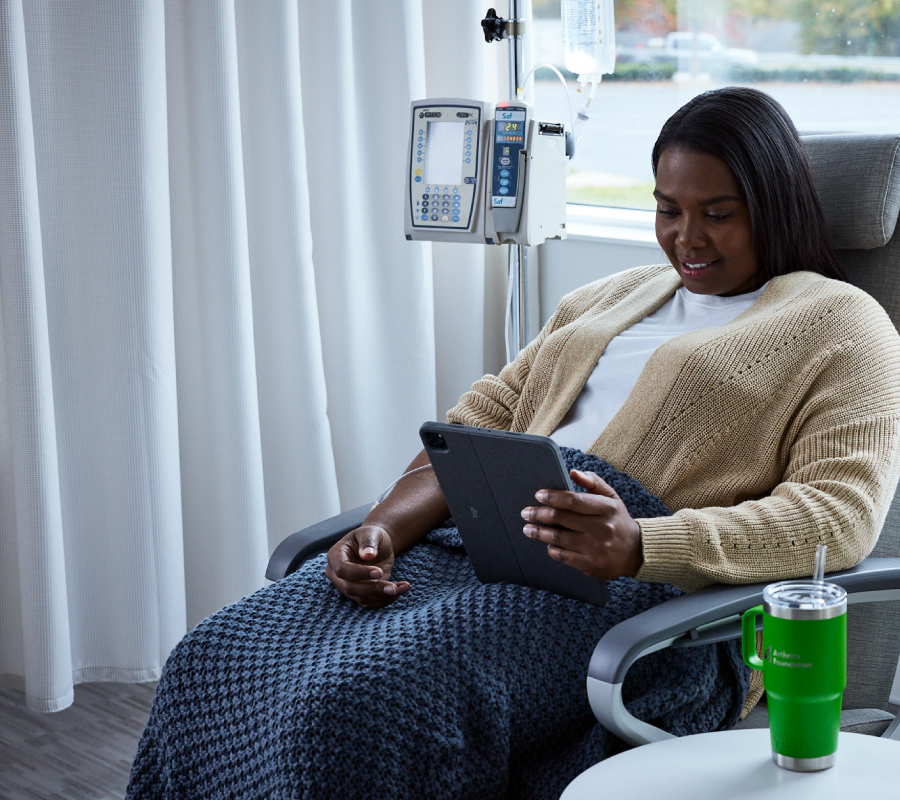Having Psoriasis Raises Your Risk of Psoriatic Arthritis
If you have this skin condition as well as joint pain, you might be one of the roughly 30% of people with psoriasis who also develop psoriatic arthritis.
By Linda Rath | April 8, 2025
Psoriasis is one of the most common skin conditions, but it is also a shape-shifter, taking different forms at different times in different people. Symptoms can range from a burning rash covering the whole body to a few dandruff-like flakes. Plaque psoriasis, by far the most common type, is marked by dry, scaly patches, usually on the elbows, knees and scalp. These may be few and far between or more extensive, and like other forms of psoriasis, they may flare and then temporarily disappear. Although considered a chronic condition, psoriasis can occasionally go into long-term remission. It’s also possible to have more than one type of psoriasis at the same time or at different points in life. No matter when it occurs or how serious it is, psoriasis can be a miserable condition that strikes at a person’s physical and emotional well-being.
Psoriasis in Skin of Color
Because plaques look different on darker skin – they’re purple or dark brown instead of reddish, as on white skin – psoriasis is frequently under- or undiagnosed in people of color. It’s also often not effectively treated, in part because white dermatologists often don’t learn about it. The American Academy of Dermatology issued a plea in 2023 for more and better depictions of skin conditions in people of color in medical textbooks and equity in clinical trials. It’s now backing various efforts to rectify dermatology’s color problem by actively recruiting providers of color and doing a better job of educating white professionals.
What Causes Psoriasis?
Psoriasis is an immune-mediated inflammatory disease, meaning that the immune system attacks not only invaders, like bacteria and viruses, but the body’s own tissues. Psoriasis is marked by skin cells that turn over too quickly – every three or four days instead of the usual 28. The blizzard of skin cells piles up on the skin’s surface, creating thick patches. Exactly what jump-starts this process isn’t clear, but like most autoimmune diseases, it seems to be a combination of genetic and environmental factors. For people with certain genes that make them vulnerable, environmental triggers can include:
• A reduction in the number and variety of beneficial bacteria that inhabit the gut and skin (called dysbiosis)
• Stress
• A bacterial or viral infection
• Smoking – most studies suggest smokers are at least twice as likely as nonsmokers to develop psoriasis
• Heavy alcohol use
• An injury to the skin
• Certain medications, including drugs that treat high blood pressure and antimalarial drugs, and in a few instances, biologics called tumor necrosis factor (TNF) blockers used to treat other autoimmune conditions
• Possibly hormonal changes, especially during menopause
The Road to Psoriatic Arthritis
Inflammation in psoriasis can affect nearly any organ in addition to the skin, including the heart, pancreas, blood vessels, intestine, brain and eyes. But the most frequent complication is probably psoriatic arthritis (PsA), a chronic inflammatory disease affecting the joints and the tendons and ligaments that attach to bone (entheses). About 30% of people who have skin symptoms develop PsA within a decade, although arthritis can sometimes appear first.
In the last few years, scientists have made remarkable progress in understanding the link between the two diseases. Jose Scher, MD, who directs the Psoriatic Arthritis Center at NYU Langone Health, was among the first to point to the microbiome – the trillions of mostly beneficial bacteria, viruses and fungi that live in and on the body, including the skin and intestinal tract. Dr. Scher’s lab found similar microbial and genetic patterns in people who have psoriasis and PsA as well as in those with inflammatory bowel disease. These patients also appeared to consume too little fiber, which may help prevent inflammatory arthritis, diabetes, heart disease and cancer.
Blame the Immune System
The common denominator in almost all chronic inflammatory conditions is the immune system, which gut microbes help shape and regulate throughout life. When the intricate and complex microbial balance is disturbed – by trauma, stress, antibiotics, too much alcohol or unhealthy food and too little exercise – the immune system no longer helps protect against disease or keeps inflammation in check.
Out-of-control inflammation seems to be the main culprit in most chronic diseases and explains why people with an inflammatory skin disease can later develop inflammation in their joints. It’s also possible to have psoriasis and another type of autoimmune arthritis, such as rheumatoid arthritis (RA).
Women are often diagnosed with PsA as much as a decade later than men. That’s according to research by Lihi Eder, MD, PhD, a rheumatologist and researcher with the University of Toronto. Dr. Eder says women who experience musculoskeletal symptoms may not show early signs of them on typical exams, so they may not be offered the same advanced diagnostic tests as men are.
The key takeaway for both men and women who have psoriasis is to not ignore joint pain. It may not be arthritis, but it should be checked. A rheumatologist may have more experience diagnosing PsA than a primary care doctor or dermatologist. And women should ask for ultrasound imaging, which is better at picking up early signs of PsA than X-rays are.
Psoriasis patients can also take steps to improve symptoms and reduce the chance of progressing to PsA. Many studies have shown that prebiotics such as fiber combined with certain probiotic and short-chain fatty acid supplements may reduce psoriasis symptoms and systemic inflammation. Other studies have shown that a Mediterranean-style eating plan can help shift the microbiome to a healthier state.
In addition, Brent Bauer, MD, who directs Mayo Clinic’s Complementary and Integrative Medicine Program, suggests the importance of:
• Optimal nutrition
• Daily exercise
• Restorative sleep
• A daily mind-body practice
• Social connectedness
• Time in nature
This article was developed independently by the Arthritis Foundation. We are grateful for the support of our sponsors - Amgen, BMS, Johnson & Johnson and UCB.
Psoriasis is one of the most common skin conditions, but it is also a shape-shifter, taking different forms at different times in different people. Symptoms can range from a burning rash covering the whole body to a few dandruff-like flakes. Plaque psoriasis, by far the most common type, is marked by dry, scaly patches, usually on the elbows, knees and scalp. These may be few and far between or more extensive, and like other forms of psoriasis, they may flare and then temporarily disappear. Although considered a chronic condition, psoriasis can occasionally go into long-term remission. It’s also possible to have more than one type of psoriasis at the same time or at different points in life. No matter when it occurs or how serious it is, psoriasis can be a miserable condition that strikes at a person’s physical and emotional well-being.
Psoriasis in Skin of Color
Because plaques look different on darker skin – they’re purple or dark brown instead of reddish, as on white skin – psoriasis is frequently under- or undiagnosed in people of color. It’s also often not effectively treated, in part because white dermatologists often don’t learn about it. The American Academy of Dermatology issued a plea in 2023 for more and better depictions of skin conditions in people of color in medical textbooks and equity in clinical trials. It’s now backing various efforts to rectify dermatology’s color problem by actively recruiting providers of color and doing a better job of educating white professionals.
What Causes Psoriasis?
Psoriasis is an immune-mediated inflammatory disease, meaning that the immune system attacks not only invaders, like bacteria and viruses, but the body’s own tissues. Psoriasis is marked by skin cells that turn over too quickly – every three or four days instead of the usual 28. The blizzard of skin cells piles up on the skin’s surface, creating thick patches. Exactly what jump-starts this process isn’t clear, but like most autoimmune diseases, it seems to be a combination of genetic and environmental factors. For people with certain genes that make them vulnerable, environmental triggers can include:
• A reduction in the number and variety of beneficial bacteria that inhabit the gut and skin (called dysbiosis)
• Stress
• A bacterial or viral infection
• Smoking – most studies suggest smokers are at least twice as likely as nonsmokers to develop psoriasis
• Heavy alcohol use
• An injury to the skin
• Certain medications, including drugs that treat high blood pressure and antimalarial drugs, and in a few instances, biologics called tumor necrosis factor (TNF) blockers used to treat other autoimmune conditions
• Possibly hormonal changes, especially during menopause
The Road to Psoriatic Arthritis
Inflammation in psoriasis can affect nearly any organ in addition to the skin, including the heart, pancreas, blood vessels, intestine, brain and eyes. But the most frequent complication is probably psoriatic arthritis (PsA), a chronic inflammatory disease affecting the joints and the tendons and ligaments that attach to bone (entheses). About 30% of people who have skin symptoms develop PsA within a decade, although arthritis can sometimes appear first.
In the last few years, scientists have made remarkable progress in understanding the link between the two diseases. Jose Scher, MD, who directs the Psoriatic Arthritis Center at NYU Langone Health, was among the first to point to the microbiome – the trillions of mostly beneficial bacteria, viruses and fungi that live in and on the body, including the skin and intestinal tract. Dr. Scher’s lab found similar microbial and genetic patterns in people who have psoriasis and PsA as well as in those with inflammatory bowel disease. These patients also appeared to consume too little fiber, which may help prevent inflammatory arthritis, diabetes, heart disease and cancer.
Blame the Immune System
The common denominator in almost all chronic inflammatory conditions is the immune system, which gut microbes help shape and regulate throughout life. When the intricate and complex microbial balance is disturbed – by trauma, stress, antibiotics, too much alcohol or unhealthy food and too little exercise – the immune system no longer helps protect against disease or keeps inflammation in check.
Out-of-control inflammation seems to be the main culprit in most chronic diseases and explains why people with an inflammatory skin disease can later develop inflammation in their joints. It’s also possible to have psoriasis and another type of autoimmune arthritis, such as rheumatoid arthritis (RA).
Women are often diagnosed with PsA as much as a decade later than men. That’s according to research by Lihi Eder, MD, PhD, a rheumatologist and researcher with the University of Toronto. Dr. Eder says women who experience musculoskeletal symptoms may not show early signs of them on typical exams, so they may not be offered the same advanced diagnostic tests as men are.
The key takeaway for both men and women who have psoriasis is to not ignore joint pain. It may not be arthritis, but it should be checked. A rheumatologist may have more experience diagnosing PsA than a primary care doctor or dermatologist. And women should ask for ultrasound imaging, which is better at picking up early signs of PsA than X-rays are.
Psoriasis patients can also take steps to improve symptoms and reduce the chance of progressing to PsA. Many studies have shown that prebiotics such as fiber combined with certain probiotic and short-chain fatty acid supplements may reduce psoriasis symptoms and systemic inflammation. Other studies have shown that a Mediterranean-style eating plan can help shift the microbiome to a healthier state.
In addition, Brent Bauer, MD, who directs Mayo Clinic’s Complementary and Integrative Medicine Program, suggests the importance of:
• Optimal nutrition
• Daily exercise
• Restorative sleep
• A daily mind-body practice
• Social connectedness
• Time in nature
This article was developed independently by the Arthritis Foundation. We are grateful for the support of our sponsors - Amgen, BMS, Johnson & Johnson and UCB.

Stay in the Know. Live in the Yes.
Get involved with the arthritis community. Tell us a little about yourself and, based on your interests, you’ll receive emails packed with the latest information and resources to live your best life and connect with others.




